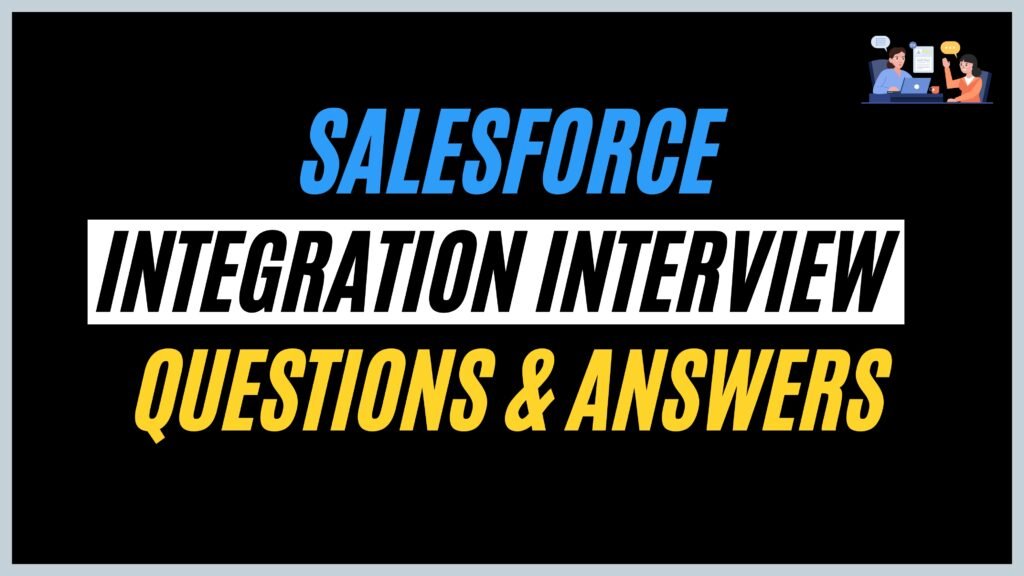Salesforce Integration Interview Questions and Answers

Integration in Salesforce simply means connecting Salesforce with other systems so they can share data and work together smoothly.
This blog covers 30+ important Salesforce Integration interview questions and answers, including real-world scenarios. Each question is explained in detail with clear answers, syntax, and code examples wherever needed.
Let’s move forward with Salesforce Integration Interview Questions and Answers
Question 1. What integration options does Salesforce offer today?
Salesforce offers or we can use REST and SOAP APIs, Bulk APIs for large loads, Platform Events and Change Data Capture for event-driven needs. Streaming/Pub-Sub for real-time, Salesforce Connect for external objects, External Services for declarative API wiring and middleware (MuleSoft, Heroku, AWS) for heavy transformations.
Question 2. When is Named Credential preferred over Remote Site Settings?
Named Credentials centralize endpoint + auth and remove secrets from code. Prefer Named Credentials for modern callouts; Remote Site Settings are legacy and required only when Named Credentials aren’t used.
Question 3. What is a Connected App, and when is it required?
A Connected App enables OAuth flows and controls scopes/policies for external apps connecting to Salesforce. We can use it for OAuth Web Server, JWT Bearer, and other delegated auth flows.
Question 4. How to choose between synchronous vs asynchronous integration?
If immediate user feedback is required, pick synchronous (REST/SOAP) with timeouts in mind. For high volume or long processing, choose asynchronous patterns (Platform Events, Batch, Bulk API).
Question 5. What’s the easiest way to keep secrets out of Apex code?
Use Named Credentials, Auth. Providers, Protected Custom Metadata, or Certificate & Key Management (for mTLS). Avoid plaintext in Apex.
Question 6. How to integrate without copying large datasets into Salesforce?
Use Salesforce Connect (external objects) or a thin cache in Salesforce with middleware that serves heavy read operations externally.
Question 7. How to test outbound callouts in Apex?
Use HttpCalloutMock (or WebServiceMock) in Apex test classes and set Test.setMock(…) so test methods don’t perform real HTTP calls.
Question 8. How do Platform Events differ from Change Data Capture (CDC)?
Platform Events are custom business events that are published manually, while CDC publishes DML changes automatically for tracked objects. We can use CDC for data synchronisation and Platform Events for business workflows.
Question 9. How to synchronize between Salesforce and a Warehouse Management System (WMS) in real time?
Publish inventory changes as Platform Events from Salesforce and make them as WMS subscribe or vice versa. For high throughput use middleware (buffering, dedupe, mapping).
Question 10. A partner sends order updates via webhooks. How to securely receive them?
Expose a secure endpoint (Heroku or middleware) with signature (HMAC) validation and mutual TLS if required; then validate and enqueue processing into Salesforce via REST or Platform Events.
Question 11. How to import a massive historical customer dataset without hitting limits?
Use Bulk API v2 or an ETL tool; perform dry runs in a sandbox, split loads by partitions, and monitor job results for retries.
Question 12. How to avoid duplicate contacts when multiple systems add the same person?
Use External ID fields and upsert, implement dedupe rules and matching logic in middleware, and maintain an external-to-Salesforce ID mapping.
Question 13. How to authenticate server-to-server integrations without user interaction?
Use OAuth JWT Bearer or a client credentials flow (if supported). JWT is recommended for secure server-to-server with no user prompts.
Question 14. What’s an efficient way to notify an external ERP when Opportunities close?
Publish a Platform Event on Opportunity Stage change and let middleware subscribe and push updates into ERP with transformation, retry and idempotent logic.
Question 15. A legacy partner only accepts XML/SOAP. How to integrate?
We may call the legacy SOAP endpoint directly from Apex (generate WSDL classes) or use middleware to translate JSON/REST to XML/SOAP.
Question 16. How to support mobile app offline sync with Salesforce?
Use Mobile SDK / SmartSync patterns or let the mobile app store changes locally and sync via middleware using bulk/upsert endpoints with conflict resolution rules.
Question 17. What is the “Fire-and-Forget” pattern?
The “Fire-and-Forget” pattern in Salesforce is an integration strategy where Salesforce sends a request to an external system but does not wait for a response, which makes it ideal for asynchronous tasks where immediate feedback is not necessary.
Question 18. What does “Queue-Based Load Leveling” solve?
It smooths traffic spikes by enqueuing events/requests and processing at a steady rate, preventing overload on external targets.
Question 19. Describe the “API Composition” pattern.
A facade aggregates data from multiple services (including Salesforce) into a single response for client apps, reducing client-side orchestration.
Question 20. Why use a “Canonical Data Model” in middleware?
It standardises data mappings between systems, reducing point-to-point transformations and simplifying changes across many integrations.
Question 21. What is “Data Virtualization” (Salesforce Connect) best for?
When data needs to be visible in Salesforce without duplication. e.g. very large product catalogs or read-heavy external databases.
Question 22. When to use “Compensating Transactions” (SAGA)?
When distributed transactions cannot be ACID across systems, provide rollback or corrective actions when parts of a workflow fail.
Question 23. How to implement the OAuth JWT Bearer flow for an integration server?
Create a Connected App, upload public cert, sign JWT with private key, exchange JWT at token endpoint and receive an access token for API calls.
Question 24. How to make callouts idempotent to prevent duplicate side-effects?
Add an idempotency key to payloads, persist request IDs and make external systems detect/reject duplicates.
Question 25. How to scale handling of high-volume Platform Events?
Use the Pub/Sub API or CometD with multiple durable subscribers and partitioned processing in middleware for parallelization.
Question 26. A third-party needs to query Salesforce frequently, but must avoid the API limit exhaustion. What can be done?
Push change notifications via CDC/Platform Events to middleware instead of letting the third party poll frequently; cache or expose a read API.
Question 27. How to implement mutual TLS for sensitive partner endpoints?
Upload client cert to Salesforce Certificate & Key Management and configure Named Credential to use mutual TLS for callouts.
Question 28. How should schema changes be handled for External Services/OpenAPI?
Version the OpenAPI definition, update Flow invocations incrementally and maintain backward compatibility in middleware or separate endpoints.
Question 29. How to do transactional integrity across Salesforce and an external DB?
Aim for eventual consistency; use SAGA/compensation transactions and idempotency to handle partial failures.
Question 30. Provide a simple Apex callout using Named Credential (snippet).

Question 31. How to publish a Platform Event from Apex?

Question 32. How to subscribe externally to Change Data Capture?
Use CometD or Pub/Sub API to subscribe to ObjectChangeEvent channels; handle replayId for at-least-once delivery.
Question 33. How to send large CSV loads into Salesforce?
Use Bulk API v2 with CSV files, create a job, upload CSV and monitor job results.
Question 34. How to do callout testing in Apex?
Implement HttpCalloutMock that returns canned responses for the request, then call code with Test.setMock() in test methods.
Question 35. How to configure Named Credential to use OAuth?
Create an Auth. Provider or Connected App, then create a Named Credential referencing that Auth. Provider so Salesforce manages tokens.
Question 36. How to publish Platform Events from an external system using REST?
POST authenticated JSON to /services/data/vXX.X/sobjects/MyEvent__e the body; response includes success and event id.
Looking to learn Salesforce Flow? Check out the complete Salesforce Flow Mastery Course here
Conclusion
Mastering Salesforce Integration is crucial for modern Salesforce development. Therefore, this set of 30+ interview questions and answers, including detailed scenarios and examples, provides a comprehensive understanding of Salesforce Integration concepts and practices.
Whether you’re preparing for an interview or looking to enhance your skills, these questions will help you gain confidence and proficiency in Salesforce Integration concepts.

